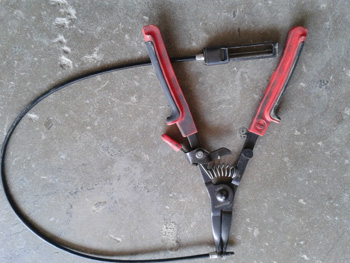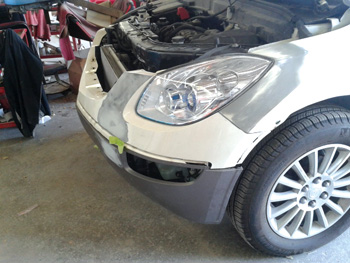
By Joe Palumbo
When I began this trade in 1976, collision repair professionals were known as bodymen and fendermen. Most of us did what was known as combo work, which meant that you took the job from start to finish. You straightened the frame, replaced or repaired the panels and, lastly, painted the car. Some of us were better at painting, some were better at bodywork or framework. One guy did it all, including those woodgrain decals on those 1970s station wagons.
Now, in our modern world, bodywork has become very complex and oftentimes vehicle or model specific. There are many operations that body techs simply don’t get paid to perform. These operations must be done, so the tech basically does them for free. For example, insurers normally know that many clips break or are one-time use, but who pays your tech to change out 28 clips in a GMC Acadia rocker molding? And that’s just one molding. Remember, to set up a car and clamp the pinchwelds, you need to remove two moldings, so that’s 48 clips, plus time to remove the broken ones and replace them with new ones.
How about nameplates and bodyside moldings? Insurers will pay to clean and retape the molding, but who pays to remove the residual adhesive left on the body? You do, my friend. For all you shop owners and managers who think clean and retape means the molding and the body, remember that just to clean and retape a molding can take awhile, let alone cleaning residual adhesive from a door, tailgate or fender. These are two separate labor operations and should be paid for as such.
Radiators/Power Steering
Years ago, when you replaced a radiator you bolted the new one in, filled it with coolant and you were done. Now, modern vehicles have sophisticated cooling systems which can develop air pockets. The modern cooling system must be vacuumed much like an air conditioning system, filled under a vacuum and then run to ensure proper operation of the cooling fans. This can take 30 minutes or more, tying up a stall.
Remember, you got paid to install a radiator. That in and of itself is a difficult and time-consuming task – made even harder if you don’t have the specialized tool to grip the spring-loaded clamps found on most cars today. Don’t tell me your channellock pliers work just fine. They won’t fit everywhere. Trust me, I’ve tried.
This same rule applies to power steering systems. They must be run for awhile, wheels turned lock to lock multiple times and fluid checked multiple times. So unless your customer likes their steering gear to howl like a timber wolf in the north woods, this is a necessary and customary procedure that must be performed when the power steering system is opened for any reason.
 Wheelhouse Liners
Wheelhouse Liners
Next, let’s talk about wheelhouse liners. Painters need them out of the car to prevent overspray, and insurers pay us to remove them, right? If you answered yes, you’re partially correct. They pay us to remove and install one time. But our body tech performs this task twice, the first time prior to the paint work being done and the second time during assembly. And the .3 that this pays hardly covers the time we spend jacking up the car, supporting it on a stand and removing the liner. Sometimes you can get paid to remove the wheel if that’s necessary.
How about fire prevention? As techs, we must protect interiors, seats, carpets, seatbelts and glass from welding sparks. It takes time to place blankets and protective welding paper over all these areas. Our fine insurance partners seem to have no problem paying a painter to drape a piece of paper over a door jamb, mask jamb or mask engine compartment. They do have a problem paying for fire protection. What are the repercussions of not masking a door jamb or engine compartment? Overspray. How about not covering the interior or windshield? You guessed it. You better have your glass company on speed dial to replace the windshield. A burned seat cover can cost $500 or more at a trim shop. Last time I checked, the dealer wasn’t giving away seatbelts either.
Mock-Up Time
Does anybody know what mock-up time would be? Let’s say your tech straightens a fender or a quarter panel. It’s Friday, and our delivery day is today. Not a problem, as the vehicle has already been refinished. All that’s left to do is install a headlamp or tail lamp. Uh-oh. Our repaired quarter panel is in about half an inch. The tail lamp won’t fit. You try slotting the lamp and moving the other side inboard so it looks correct, but to no avail. It still looks like it was straightened by an amateur. You have no choice but to re-repair the quarter panel and refinish it again. This time, you’ll test fit or mock up the tail lamp.
There are a lot of programs on cable pertaining to restoration and custom shops. These guys are professionals in every sense of the word and still feel the need to check and double-check their workmanship. Why shouldn’t we do the same and, more importantly, be compensated accordingly?
 Aftermarket Parts
Aftermarket Parts
Allow me to address aftermarket headlamps. They’re a great savings for insurers. Some are even comparable in appearance to original equipment. The main issue with aftermarket headlamps is that most, if not all, come without wiring harnesses and bulbs. Your tech is paid .3 to install a headlamp, but that’s assuming it’s plug and play. Not so in my experience. A tech is responsible to transfer the wiring, check bulbs and hope they fit in the imitation headlamp. Hopefully, the harness isn’t damaged because your headlamp did not come with a harness.
Let’s touch on like, kind and quality (LKQ) and used parts. GM Bulletin #B 06-08-51-005 pertains to caulking OE and LKQ parts. Some foreign manufacturers still caulk their replacement parts. General Motors doesn’t. GM requires a minimum bead thickness and width for the caulked seam. This is very difficult and requires the LKQ or OE part to be masked. This is definitely something we, as repair professionals, should be compensated for. Caulk, tape, labor.
Get With the Times
As vehicles become more complex, our compensation should be more in line with the times. It ain’t the ‘70s anymore, guys.
Joe Palumbo is a body and frame technician with Haggerty Buick GMC. He can be reached at [email protected].














